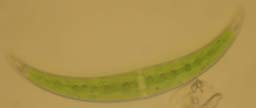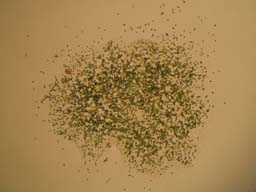| Late Summer Wanderings
by
Howard Webb (St. Louis, MO, USA) |
Introduction
Late summer is an interesting time for exploring, especially
for daphina. Results are very unpredictable, as water quality and temperatures
are quite variable. The spring population blooms are past, and many temporary
ponds have dried up (especially with the current drought in the U.S. midwest).
In late July, I was out for a hike at the Arboretum. It has been several
years since I have been there, and they have added a wetlands area since my
last visit. This was my destination, with the intent to see what was there,
and what might have moved into the new habitat.
Location
The Arboretum (Shaw
Nature Preserve) is located in Grey Summit, MO, about 30 miles south-west
of St. Louis. It was purchased by the Missouri Botanical Gardens in 1925,
to protect plants from the St. Louis gardens, which were being threatened by
high levels of smog (caused by coal furnaces). The farm land was never
needed for the intended purpose, and has over time been restored to prairie
and other native habitat. The wetland was added several years ago, by damming
up a small stream.
Much of the wetland pond was dry, though there was standing
water at the end toward the dam. What was accessible was covered in water
lilies, and had a water depth of not more than 50cm. The water temperature
was reading about 30°C.
Technique
A water sample was take using a cup on the end of my walking
stick. The sample was then transported home in a recycled water bottle.
The sample showed a diversity of specimens, actually better
than what I thought I would find for this time of year (particularly due to
the water temperature). I filtered the sample through silk-screen fabric, and
wet-mounted what was retained on the cloth.
The diversity of specimen size makes for some problems.
A number of the daphnia were partially crushed under the cover slip, while the
smaller rotifers and ciliates were vigorously moving around (even from under
the cover-slip, to the excess water around the edges). It was impossible to
photograph some of these smaller critters (at 400x) due to their size and speed.
In particular, I noticed several ciliates (spirotrichea?) and chlorophyta (micrasterias)
and possibly a volvox.
To try and slow them down, I added some club soda to the
slide (the CO2 reduced their oxygen, and hence their behavior). Unfortunately,
I added too much and most of the soft body animals exploded.
Images
The sub-stage light was greatly reduced (via a rheostat)
to increase detail visibility. This does however produce a dark brown
image, which was subsequently adjusted with the software (increase gamma and
contrast). All images have been reduced from their original size.
Click
images to view a larger version.
|
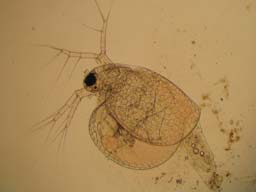
|
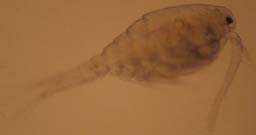
|
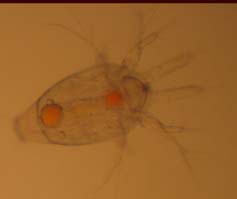
|
| Ceriodaphnia
100x, bright field
62K file |
Copepod
40x, bright
23K file |
Copepod
nauplius (larvae)
100x, bright field
36K file |
|
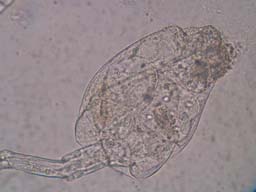
|

|
Chlorophyta
closerium
400x bright field
21K file
|
Rotifer (Scaridium)
400x bright field
77K file
|
Rotifer (Scaridium)
100x bright field
same as one to left, but showing full body.
28K file
|
|
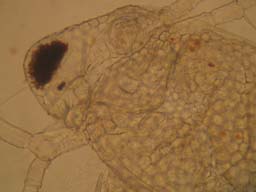
|
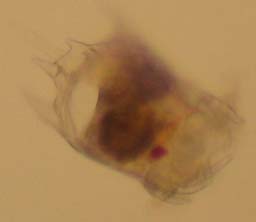
|
|
|
Ceriodaphnia (head)
400x bright field
68K file |
Rotifer (Brachionidae?)
400x bright field
14K file
|
Remains of unknown
chlorophyta
100x bright field
103K file |
Technical Details
Environmental Conditions
Water temperature: 30°C.
Depth: 50 cm
Location: 38.4760 N 90.8055 W (approx.)
Microscope: Bausch & Lomb monocular, 10x ocular, 4x, 10x and 40x
objectives.
Camera: Canon PowerShot A70 3.2 megapixels,
2048x1536 original pixel size. Pictures taken using remote control software
from a computer.
Software: Photoshop Elements
References
Shaw Nature Preserve
Missouri
Botanical Gardens
Comments to the
author Howard
Webb are welcomed.
codebase="./" code="email.class" name="emailer" archive="email.jar" align="bottom" height="2" width="2">© Microscopy UK or
their contributors.
Published in the August
2005 edition of Micscape Magazine.
Please report any
Web problems or offer general comments to the Micscape
Editor,
via
the contact on current Micscape Index.
Micscape is the
on-line monthly magazine of the Microscopy UK web
site
at http://www.microscopy-uk.org.uk/



